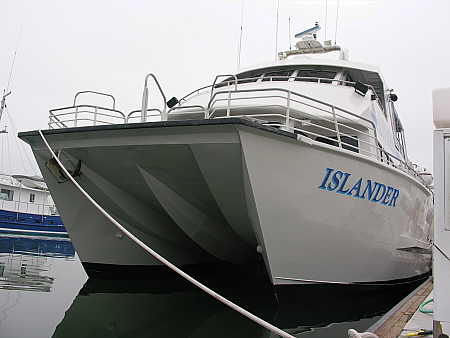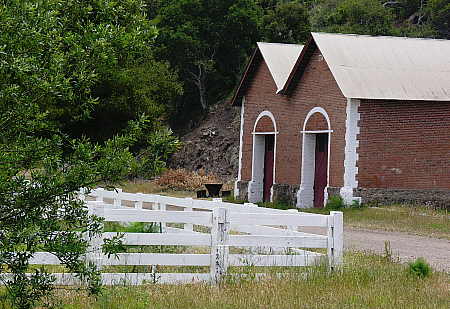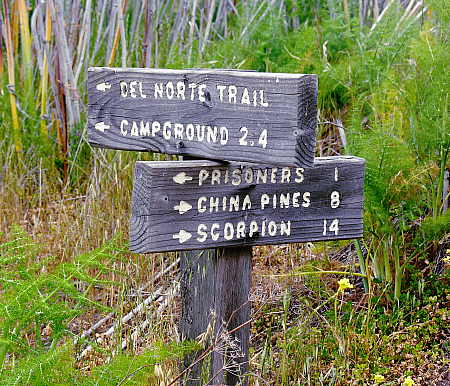The Channel Islands consists of eight island masses off the coast of Southern California. In 1980 the United States Congress established Channel Islands National Park, which includes the northernmost five of these islands, in order to study, protect and preserve the unique resources of these remarkable islands. Along with the National Park, the Channel Islands National Marine Sanctuary (administered by the National Oceanographic and Atmospheric Administration (NOAA), was also established in 1980 to protect the marine resources of the waters surrounding the islands.
I have been a frequent visitor to the Channel Islands over the past 32 years, starting with my involvement in the sport of scuba diving in 1975. My wife and I also spent some five years living aboard our diesel-powered trawler, with nearly two of those years spent “on the hook” (otherwise known as being anchored) in the lee of the various anchorages scattered around the Channel Islands. The love I have for these islands runs deep, and the degree to which I miss them is palpable at times.
Since my involvement predates the establishment of Channel Islands National Park, I have seen many, many changes that have occurred in the ownership and use patterns on these islands. Now that it has been 7 years since relocating to the Ozarks, you can imaging how much of a longing I have felt to return to the islands for a visit. On a recent trip to California, I decided to devote a day to reacquainting myself with the largest of the Channel Islands, which is Santa Cruz Island.
Numerous commercial dive and sport fishing boats frequent the islands from their home ports on the mainland, but to actually land on the islands requires either access to a private, seaworthy vessel, or the utilization of the services provided by Island Packers, the exclusive concessionaire to the NPS for the Channel Islands.
Round trip fare to Santa Cruz Island runs $46, and it entitles you to passage aboard the Islander, a 64 foot X 24 foot, 149 passenger catamaran built by All American Marine, as seen in the photograph above. This vessel was commissioned in 2001, is equipped with super-low emission diesel engines, burns bio-diesel fuel, and can operate at approximately 20 knots, offering a quick and comfortable ride across the Santa Barbara Channel.
As the Islander heads for the breakwater, you will see the Channel Islands National Park headquarters and visitor center, located in the heart of Ventura Harbor. As with all National Parks, the center is a valuable resource for visitors to the park, providing information, interpretive programs and expertise to make your visit both safe and enjoyable.
Since the islands are only accessible by boat, the Park Service operates several vessels used in the management of the park resources. The vessel seen above is the largest in the CINPS fleet. The CINPS also operates a landing ship craft (LSC) which is used to transport materials and equipment to and from the islands.
Any transit from the mainland of California to any one of the northern Channel Islands requires crossing the Santa Barbara Channel. If you examine the nautical chart at the top of this post, you may see that this entails crossing both a northbound and a southbound designated shipping channel. For those unfamiliar with what a designated shipping channel is, it is basically a pair of sea lanes, separated from each other by a defined separation zone, which is used by large commercial vessels and controlled by specific rules and regulations.  One of the rules states that a vessel, properly navigating within a shipping channel, has absolute right-of-way over any other vessel crossing the shipping lanes. The shipping channel that exists within the Santa Barbara Channel is a very busy place, as it is a primary route for the entire west coast maritime shipping trade. You can see from the photograph above that we crossed paths with at least one large container ship as we worked our way over to Santa Cruz Island.
When we arrived at Santa Cruz Island, the captain cruised past Scorpion Rock (shown above), which has become a favorite roosting spot for the California brown pelican, which is listed as an endangered species resulting from the DDT fiasco of the mid-20th century that threatened the survival of many different bird species prior to the eventual ban on it’s use. The brown pelican, happily, is making a fine recovery at this time.
After unloading passengers (mostly school children) at Scorpion, the crew of the Islander offload the kayaks that they have transported to Santa Cruz Island. Santa Cruz is a sea kayaker’s paradise, with kelp beds and sea caves as the primary attraction. The sea caves of Santa Cruz Island are known internationally, and Painted Cave, located on the north side of the island, is the largest known navigable sea cave in the world. I have been aboard dive boats that have pulled into this cave, which is a feat that can only be accomplished on the calmest of days.
After dropping off most of the passengers at the Scorpion ranch area, the Islander continued on to a spot called Prisoners Harbor. There were only a half-dozen people landing at Prisoners, including myself. All of the other passengers headed off to the west, into land owned by The Nature Conservancy, guided by a biologist from Island Packers. Anyone who knows me would not be surprised that I chose to head in another direction – eastward towards Potato Harbor. There’s something to be said for getting away from the crowds!
Along the way, I passed many relics from Santa Cruz Island’s ranching past. The island had been owned by a Dr. Stanton prior to the establishment of the National Park, and was used as an active cattle ranch. In 1978, The Nature Conservancy bought approximately 90% of the western portion of Santa Cruz Island from Dr. Stanton, who was permitted to continue ranching operations for a limited time. On Dr. Stanton’s passing in 1987, the ranching operations were halted, and the cattle were removed to the mainland.
Here, in the Prisoners ranch area, are additional remains of Dr. Stanton’s ranching operation. This brick building was constructed in the late 19th century, giving some indication of how far back ranching had been a part of this island’s heritage.
Past the cattle facilities of Prisoners Harbor one can find a nice roadbed on which to begin exploring the eastern end of Santa Cruz Island. In the photograph above, you can just get a hint as to the ruggedness of the terrain on Santa Cruz Island.
Along with the dirt roadbed, which was established to aid ranching operations, there is a wonderful network of hiking trails on the island. The graded roadbed gives way to less developed trails, as shown below.
I will digress for a moment to tell you about a creature unique to these islands, the Island Fox. At one time, when sea levels were lower than they are today, fox from the mainland found their way to some of the Channel Islands. The sea levels eventually rose, thus stranding the fox on the islands. As with many other species throughout the world who become isolated in an area of limited food resources, the fox began to exhibit the trait of dwarfism, so that today the Island Fox has become an extremely diminutive animal, approximating the size of a house cat.Â
Within the past decade, there has been a drastic decline in the number of Island Fox at the Channel Islands.  On Santa Cruz, past numbers were believed to be in excess of one thousand animals. Since the decline, the number is believed to be less than 100 animals. The causes of the decline are believed to be a chain of events that looks something like this:  early ranchers introduced pigs to the island as a food source. Domestic pigs, being difficult to confine in pens, escaped captivity and eventually established a feral pig population on the island. Hunters on the island did a pretty good job of controlling the feral pig population. The National Park was established, and hunting was eventually banned on the island. With no natural predators, the feral pig population exploded. The supply of feral piglets attracted predatory Golden Eagles to the islands, whose numbers had previously been limited by competition from Bald Eagles. However, the DDT problem, previously referred to in this post, eliminated the Bald Eagle from the island, and the Golden Eagle was free to reign supreme. The Golden Eagles found the Island Fox to be easy prey, and thus the rapid decline in their numbers. A detailed and accurate discussion of the plight of the Island Fox can be found at the NPS Island Fox homepage. I have never been fortunate enough to see an Island Fox in person, even though it has been one of my aspirations for a long, long time.
But, as they say, I digress, so now, back to my day excursion.  After hiking to a remote little corner of the island, I felt the pang of hunger setting in, so I decided that it would be a good time to take a lunch break. Setting my day pack down beside me, I proceeded to enjoy the delectable ham and cheese sandwich that I had prepared for lunch. About half-way through eating the sandwich, I looked up, and what do you know, there, not five feet in front of me, was an Island Fox, standing dead-still and staring at me, as if trying to determine whether I were friend or foe. I immediately froze every muscle in my body, hoping not to startle the fox, lest he/she turn and depart in a hasty retreat. After what seemed like an eternity (but was probably only a minute or so),  I realized that I NEEDED to get a picture of this fox, otherwise my tale of encounter would be accepted with the same credibility as is afforded to those with tales (but no evidence) of Bigfoot or Loch Ness monster sightings.
Photographers among you may see this coming, but here goes anyway. My camera was turned off, with lens cap covering the lens. The camera was safely stowed in it’s carrying case, with the snap fastener securely engaged. This was all stuffed into the day pack laying on the ground next to me, and of course, the day pack was zipped shut. Lowering the sandwich to my lap, I slowly reached one hand over to my pack, where I tried to open the zipper of the pack as silently as I could. Quietly and with deliberate care, I extracted the camera out of the pack, all the while maintaining eye contact with the fox. As I fumbled with the camera case, and then the lens cap, I realized that I would probably spook the fox before I could compose a shot the way I normally try to do when taking a picture. Keeping this in mind, I decided to slowly turn the camera to face the fox, thinking that I might only get one chance to squeeze the shutter. So with the camera down by my left shin, I pointed the lens toward the fox and depressed the shutter button.  The camera fired off a shot, and the fox immediately bolted.
The picture I obtained is not one that I would consider entering into a photographic competition. In fact, it doesn’t even qualify as a decent animal ID type photo, but it certainly captures a sufficient image to verify that my story is not a tall tale, but indeed is an actual sighting. Believe me when I tell you that this encounter absolutely MADE MY DAY.
Finishing my sandwich, I noticed that it was probably time for me to start heading back towards Prisoners Harbor so that I would not miss the boat for my return to the mainland. Sure enough, the Islander could be seen pulling up to the pier at precisely the scheduled time. Boarding the boat, I found a comfortable spot to enjoy the trip back to Ventura Harbor.
After picking up passengers at the Scorpion ranch, where we had deposited them earlier in the day, we now headed over to Anacapa Island, which is the smallest of the Channel Islands included in the National Park. Here we picked up passengers who also wanted to return to the mainland. Above, you can see the steep staircase at Anacapa’s Landing Cove, which must be negotiated to explore the island. After picking up these remaining passengers, we headed back across the Santa Barbara Channel towards the home port of Ventura Harbor, but not before cruising along in the channel amongst a large pod of Pacific white-sided dolphin, who took advantage of the superb bow and stern wakes to partake in a little bit of surfing, a sport that they invented long before Hawaiians ever caught on to the concept.
Many books have been written about the Channel Islands in general, and Santa Cruz Island specifically. Although this small post does not do the subject justice, I have provided enough links to get you started in your research should you decide to visit these islands. Although the location of Channel Islands National Park ensures that it remains the least visited of all the National Parks, those who are familiar with these islands will tell you that Channel Islands National Park is the gem among gems in our park system.Â
Do plan on being one of the few who gets the opportunity to experience this wonderful resource that we are fortunate to have available to us. I can assure you, you won’t be disappointed.



















while in school at ucsb i took a day trip to anacapa island. events included a whale sighting, swimming the blow hole that surges from the other side of the island (dangerous), and hiking the island which is mostly covered in introduced ice-plant.
your fox photo reminds me of the time that i illegally climbed morrow bay rock (further north) i had a photo of the happy day as proof but alas the photo was destroyed in an ex-girlfriend purge. i can only allege the event and i have never met another person that has climbed it.